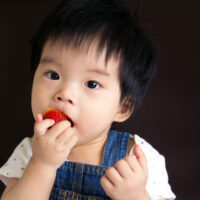I remember researching everything in my little one’s first few years of life. Being a new parent was intimidatingI just didn’t want to mess up! So, imagine my surprise when my dentist looked into Adrien’s mouth, looked over to me, and asked, Does he eat fruit snacks?
Of course, Adrien had eaten fruit snacks. They were one of his favorite foods. But how did the dentist know within a minute of looking in his mouth? The snacks were leaving behind a sticky residue that were causing bacteria build-up and wearing down the enamel on his teeth.
So, what do you do as a parent when your little one’s favorite snack is putting their smile in jeopardy? Keep reading for some more ideas on healthy ways to sneak fruit into your child’s diet and advice on how often you should let your child eat fruit snacks.
Why Are Fruit Snacks Bad?
Research has shown there are over 70 types of bacteria living in your mouth. Many of these don’t cause problems in the mouththey are there to help balance out the oral ecosystem. The problem is Streptococcus mutans, a type of bacteria that is known for causing tooth decay.
Tooth decay happens when S. mutans bacteria eats sugar left behind on the teeth. The bacteria produce acid as a byproduct when eating sugar. This acid then eats away at the enamel of teeth.
Fruit snacks, raisins, and other dried fruits are a problem for your little one’s mouth because of their sticky texture. Even organic or all-natural foods leave sugars behind on teeth. This increases the amount of acid on the enamel and eventually results in tooth decay.
How Often Should I Let My Kid Eat Fruit Snacks?
Even though your child’s dentist might condemn fruit snacks, they are a childhood favorite for many kids. To avoid a meltdown, try to limit the number of times you let your little one have fruit snacks each week. Cut back to 1-2 packs per week. You might also appease their cravings with a gummy vitamin that they take once a day (preferably before brushing their teeth).

Another useful tip is to save the fruit snacks for when you are home or close to a sink. Brushing after a gooey, sugary snack can help knock the sugar loose. If you don’t have a sink handy, encourage them to take a few sips of water to rinse after eating fruit snacks.
Proper Dental Care Following Fruit Snacks
Of course, proper dental care will also go a long way in preventing tooth decay. New parents sometimes do not realize that is even important to brush their little one’s teeth as an infant. Though toothpaste isn’t always used, using an infant toothbrush helps remove the build-up of sugars and dairy from breastmilk and formula. It can also be helpful to regularly have your little one rinse their mouth.
Once your infant becomes a toddler, you might find they are ready to stand on a step stool and brush their own teeth. Even then, you’ll want to use a fluoride-free toothpaste designed especially for little ones. If you need help choosing a toothpaste, be sure to check out our article on best infant and toddler toothpaste.
Stay Hydrated
Staying hydrated can also benefit your little one’s teeth. Teeth are constantly undergoing demineralization (which weakens enamel and strips away layers of the tooth) and remineralization (which builds on the tooth that is there). Drinking mineralized water (most cities add fluoride to the water supply) can encourage the remineralization of teeth. This is one of the reasons doctors recommend using tap instead of bottled water when possible.
Saliva also carries important minerals for dental health. For proper saliva production, your little one needs to stay hydrated. Offer water instead of sugared beverages frequently through the day.
Getting Your Toddler to Eat Fruit
One of the major reasons parents turn to fruit snacks as an alternative is because they are a fun, easy way to get their child to eat fruit. Toddlers are notoriously known for their picky eating habits. With some creative planning, however, you can easily sneak fruit into your child’s diet.
Yummy Fruit Snacks
The best fruit snacks’ are those that are made from natural fruit. Even though you may still want to offer water to rinse afterward, the sugars will not stick as much as those in fruit snacks. One tasty way to prepare fruit is to blend it into a smoothie or making a juice from it. This lets your little one try a wide variety of foodsand you can even sneak some vegetables in there, too. You could also freeze homemade fruit juice to make tasty popsicles.

Another good idea is using fruit as a topping. Spread peanut butter or cream cheese on a tortilla shell or graham cracker and let your little one place fruit on top in a fun design. Serve sliced fruit with yogurt or cottage cheese, or put it on top of oatmeal or cereal. You’ll be surprised to find how willing your child is to eat fruit when it is served with some of their favorite foods.
Lead by Example
Children look up to their parents. If they see you reaching for a piece of fruit instead of chips, they are more likely to eat them as well. You can also encourage healthier eating by making snacks like chips and cookies less available.
Involve Them
Toddlers are more likely to try something they are interested in. Take your child to the farmer’s market and let them pick out a few things to try. Encourage them to try something new each week.
Final Take
Adrien was young the first time he visited the dentist, so fortunately those sticky fruit snacks hadn’t done too much damage. We didn’t cut them out completely- we just cut back and kept maintaining his dental routine.
You don’t have to throw out all your child’s fruit snacks, but proper dental care and moderation go a long way. Teaching your little one these habits now will help them have bright, healthy teeth in the future. It can also prevent costly medical bills and painful visits to the dentist. Best of luck!






